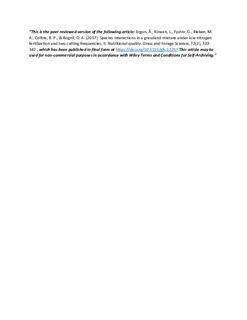| dc.contributor.author | Ergon, Åshild | |
| dc.contributor.author | Kirwan, Laura | |
| dc.contributor.author | Fystro, Gustav | |
| dc.contributor.author | Bleken, Marina Azzaroli | |
| dc.contributor.author | Collins, Rosemary P | |
| dc.contributor.author | Rognli, Odd Arne | |
| dc.date.accessioned | 2018-03-26T08:19:37Z | |
| dc.date.available | 2018-03-26T08:19:37Z | |
| dc.date.created | 2016-09-22T19:25:16Z | |
| dc.date.issued | 2017 | |
| dc.identifier.citation | Grass and Forage Science. 2017, 72 (2), 333-342. | nb_NO |
| dc.identifier.issn | 0142-5242 | |
| dc.identifier.uri | http://hdl.handle.net/11250/2492041 | |
| dc.description.abstract | Mixtures and pure stands of perennial ryegrass, tall fescue, white clover and red clover were grown in a three-cut and a five-cut system in southern Norway, at a low fertilization rate (100 kg N ha−1 year−1). The nutritional quality (annual weighted averages) of the dried forage from the two-first harvesting years was analysed. There was no significant effect of species diversity on crude protein (CP) concentration. In the three-cut system, we found a significant species diversity effect leading to 10% higher concentrations of acid detergent fibre (ADF), 20–22% lower concentrations of water-soluble carbohydrate (WSC) and 4% lower net energy for lactation (NEL) concentrations in mixtures compared with pure stands (averaged across the two-first years). In the five-cut system, similar effects were seen in the first year only. This diversity effect was associated with a reduction in WSC and NEL concentrations and an increase in ADF, NDF and CP concentrations in the grass species, and not in red clover, when grown in mixtures. This is thought to be a combined result of better N availability and more shading in the mixtures. Species diversity reduced the intra-annual variability in nutritional quality in both cutting systems. | |
| dc.language.iso | eng | nb_NO |
| dc.rights | Attribution-NonCommercial-NoDerivatives 4.0 Internasjonal | * |
| dc.rights.uri | http://creativecommons.org/licenses/by-nc-nd/4.0/deed.no | * |
| dc.title | Species interactions in a grassland mixture under low nitrogen fertilization and two cutting frequencies. II. Nutritional quality | nb_NO |
| dc.type | Journal article | nb_NO |
| dc.type | Peer reviewed | nb_NO |
| dc.description.version | acceptedVersion | |
| dc.source.pagenumber | 333-342 | nb_NO |
| dc.source.volume | 72 | nb_NO |
| dc.source.journal | Grass and Forage Science | nb_NO |
| dc.source.issue | 2 | nb_NO |
| dc.identifier.doi | 10.1111/gfs.12257 | |
| dc.identifier.cristin | 1384418 | |
| dc.relation.project | EU/FP7-244983 | nb_NO |
| dc.relation.project | Norges forskningsråd: 225330 | nb_NO |
| cristin.unitcode | 192,10,2,0 | |
| cristin.unitcode | 192,14,0,0 | |
| cristin.unitname | Institutt for plantevitenskap | |
| cristin.unitname | Miljøvitenskap og naturforvaltning | |
| cristin.ispublished | true | |
| cristin.fulltext | postprint | |
| cristin.qualitycode | 1 | |

